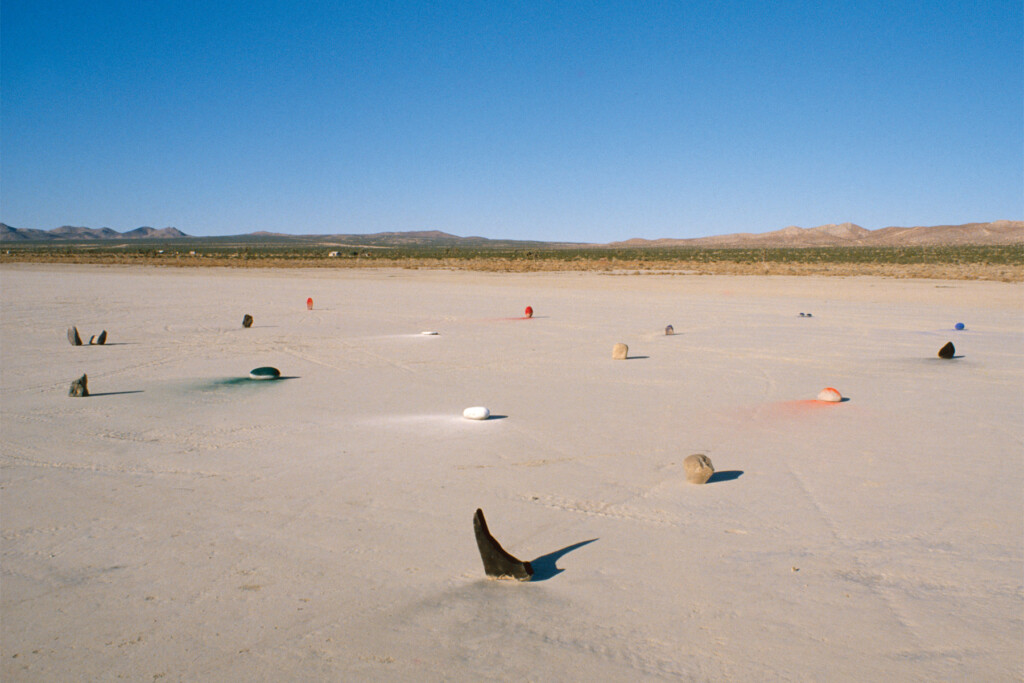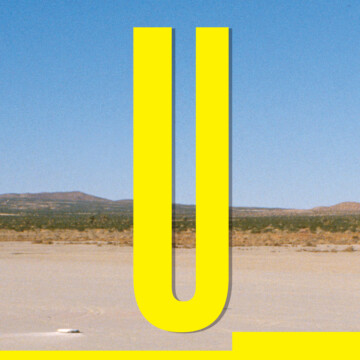
Under the Nasher Sculpture Center’s garden runs a stream. In a dry year like this one, it’s little more than a trickle, if the water flows at all. But when it rains, the underground stream can be traced from the Freedman’s Memorial Cemetery in Uptown all the way down to the Trinity River.
Curator Leigh Arnold remembers hearing about this stream when she started working at the Nasher 10 years ago. She was told the Secret Service came to do a facility sweep before former first lady Laura Bush visited the museum. A manhole cover had to be permanently sealed up because it was conceivable that someone could find the outfall and follow it underground, beneath the Design District and through Little Mexico and up into the garden.
Arnold thought the story might be apocryphal. Still she found herself sharing it with artist Mary Miss during a studio visit, in preparation for “Groundswell: Women of Land Art,” the major exhibition that opened September 23 at the Nasher and will remain on view through January 7. “Groundswell” is no less than an attempt to redefine and reconstruct the history of land art by focusing on 12 of the women artists who contributed to the field, most of whom are left out of the canon.
Miss is one of them. The 79-year-old artist has spent much of her nearly six-decade career exploring the conjunction of the built environment and the natural land. In recent years, she has become interested in exposing the seen and unseen infrastructures that organize our lives. More specifically, she has spent time recovering buried waterways. The Nasher planned to commission Miss to make a piece for the show—the only new work in a primarily historical exhibition. And what was once just a piece of museum lore has become a site-specific work of art, Stream Trace: Dallas Branch Crossing.
In the garden, Miss has created a series of polished stainless steel sculptures to mark where the stream runs beneath the ground. Throughout the run of the exhibition, local artists will host walks that take visitors from the museum along the path of the stream. For Miss, those walks are as much a part of the art as the shimmering X’s that she’s created for the garden.
“Artists can have an essential role in helping us understand our relationship to the environment and to the ecosystems that support our lives,” Miss said in a public conversation this spring with Arnold. “Walking has been one of the things that has been most important to me as a means of engaging people with a place or a space or whatever I’m trying to call to their attention.”
If the idea of visiting an exhibition only to find yourself leaving the museum sounds a bit off the wall, welcome to the world of land art.

Artists in the 1960s and ’70s were leaving behind studios and making work in nature. They traded in their canvases for lakes and mountains. Some works were passive and ephemeral; some were bombastic and permanent. The artist Walter De Maria famously said, “My new brush is the Caterpillar.”
Land art (or earth art, as it is also known) is sometimes described as an anti-gallery movement, although the broad range of art that falls under the banner can be difficult to wrangle into any one political stance. For some artists, the safe spaces of the white-wall galleries felt out of touch with the tumultuous times (e.g., the Vietnam War, the Civil Rights Movement, second-wave feminism, the space race) in which they were living. It can take the form of eco-art, drawing attention to environmental issues. Or it can interact with historic, or prehistoric, uses or misuses of the land. Sometimes, it’s not political at all. For all the artists who fall within this designation, the earth, particularly the expansive swaths of North American desert and prairie, became an object, a tool, a muse.
But the canonical understanding of land art remains fairly limited. The most famous works belong to just three artists: De Maria, Michael Heizer, and Robert Smithson. They are occasionally referred to as land art’s “trinity,” perhaps not just because of their number but because in their works they often played God, meddling with nature.
In some instances, materials were added to a remote location to manipulate or alter the landscape, such as Smithson’s Spiral Jetty, for which he added 6,000 tons of black basalt rocks to the Great Salt Lake in Utah, creating a 1,500-foot-long winding coil. Other times, elements were removed, such as Heizer’s Double Negative, for which he excised earth from a Nevada mesa to create an immense trench.
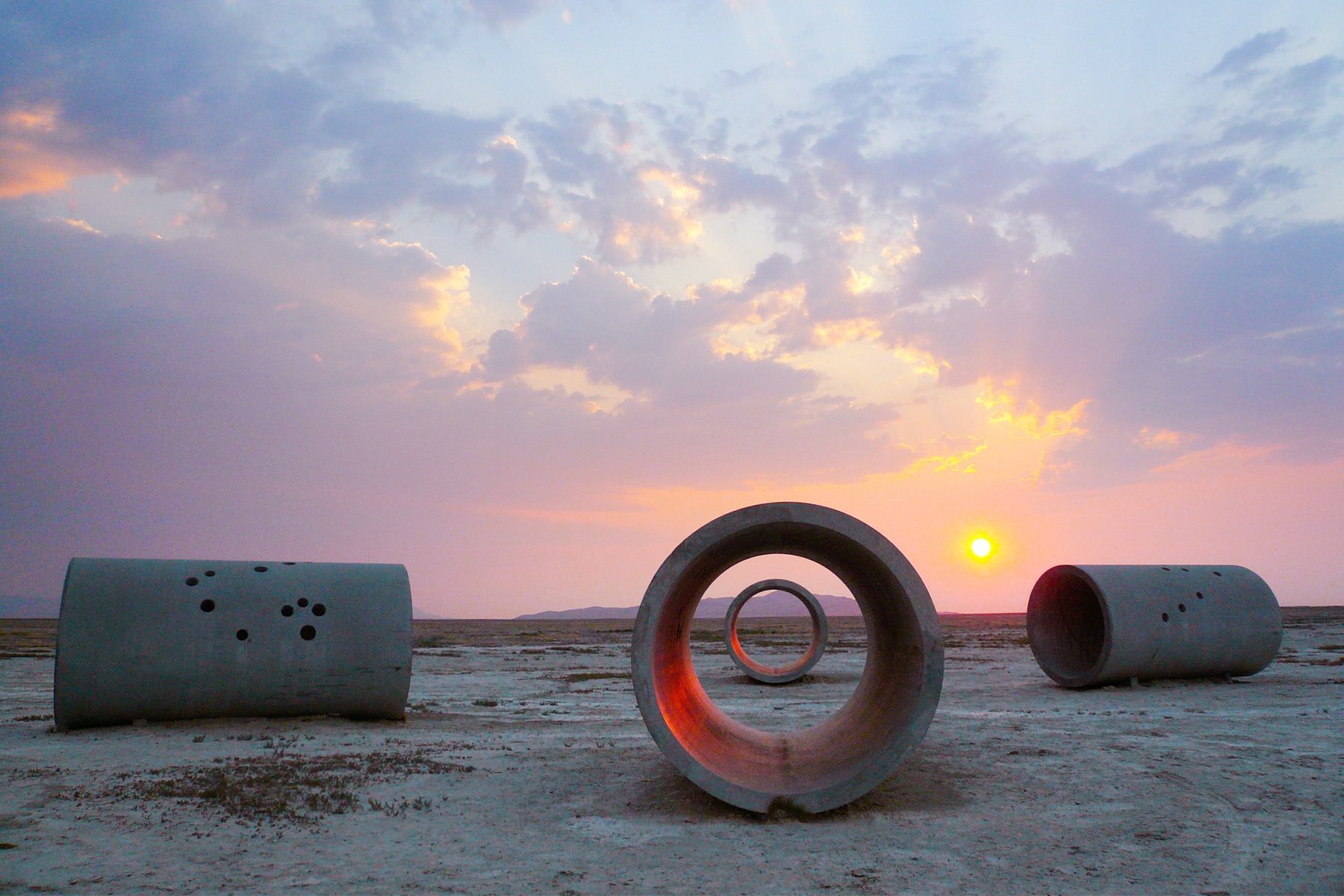
In one of De Maria’s most famous works, The Lightning Field, he placed 400 20-foot-tall polished stainless steel poles in the high desert of New Mexico that occasionally come into conversation with the electrified sky. These works were massive undertakings that allowed these artists to thrust their hubris onto the land. Forty years ago, art critic Lucy Lippard wrote of a male artist who told her, only half joking, “Nature is my slave.”
But enough about the men.
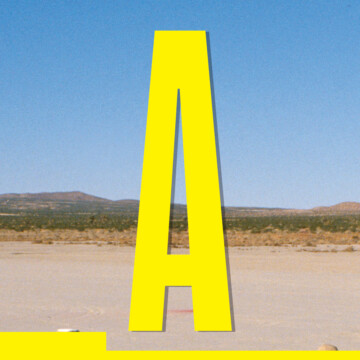
Arnold proposed the idea for an all-women land art show in 2016. She’d arrived in Dallas from Nebraska a decade earlier for a job as an executive assistant at Heritage Auctions. Along the way, she’s interned at the Chinati Foundation in Marfa, worked as a fellow at the Dallas Museum of Art, adopted three pugs, started a family (her daughter turns 3 this month), and was appointed as a curator at the Nasher in 2014. She has worked on exhibitions by David Bates, Mark Grotjahn, and Melvin Edwards and oversaw Piero Golia’s Chalet Dallas project, which transformed one of the Nasher galleries into a chic, art-forward lounge and event space. But her primary area of scholarship has remained land art.
Seven years ago, she was defending her doctoral dissertation at UTD, which she’d written on Smithson. Prior to that, she had curated a small exhibition at the DMA, “Robert Smithson in Texas,” in 2014. During that process, she met Nancy Holt, Smithson’s wife and a significant artist in her own right. For as much time as she’d spent studying contemporary art and earthworks in particular, Arnold remembers being struck by how little she knew about Holt’s career.
Although Holt was in her husband’s shadow while he was alive, she made important contributions to the field. She is most well known for Sun Tunnels, a land art installation in Utah’s Great Basin Desert. She worked with engineers, astrologists, contractors, and crane operators to create four 22-ton cylindrical concrete structures that contained the outline of constellations and are aligned with the sun’s pattern during the solstices. They are big enough that visitors can walk through them without stooping, and they become visual devices for people to see a framed view of the otherwise vast desert. But this was only the beginning for Arnold, who became enamored with Holt’s entire body of work.
“I wasn’t really taught her work in school,” Arnold says. “You just ask the question, ‘Why is that?’ And you hate to chalk it up to gender, but it made me wonder, if there’s Nancy, who else is there?”
When Arnold asks a question, her mouth curves up into a sly, scheming smile. She likes asking questions, because she really likes finding the answers. The 41-year-old curator has long, dirty-blond hair and dresses somewhere in between an East Coast academic and a millennial cool mom. Her aesthetic seems to collapse Eileen Fisher and Faherty into one closet. She always seems comfortable, cool, collected, talking slowly, methodically, until the conversation stumbles onto something surprising she discovered in her research—something she can’t wait to share with an audience. She describes that process as giving her a “charge.”

“I’m just a nerd about wanting to know things,” Arnold says. “And selfishly sharing that information, introducing people to history they might not be aware of, is just a wonderful feeling.”
The Dallas Observer once nicknamed her the “Indiana Jones of Dallas Art,” because she has spent much of her career excavating and preserving histories. Before joining the Nasher, she co-curated an exhibition at the DMA, “DallasSITES: Charting Contemporary Art, 1963 to Present,” for which she created an archive of oral histories of the city’s artists, curators, and scholars. It’s perhaps the most thorough and incisive documentation of the role art has played in Dallas to date, adding entire chapters and characters to the public record that had been previously overlooked.
“I think when you tell those stories that aren’t told so often, you’re accessing a body of knowledge that has its own network,” Arnold says. “And I guess I kind of like the underdogs.”
One of her inspirations for “Groundswell” was looking into the way the women land artists working alongside the men as peers, and even friends, were entirely erased from the history of that time. Arnold points to the two groundbreaking all-men shows from the late 1960s, “Earthworks” at the Dwan Gallery in New York and “Earth Art” at Cornell University.
It’s only in the past few years that museums have dedicated a smattering of exhibitions to important women artists from that period, including Agnes Denes and Judy Chicago. In 2018, critic Megan O’Grady, writing for the New York Times, attempted to unpack why it might’ve taken so long to give these artists their day in the sun: “Today, land art appears as an almost perfect distillation of the art world’s history of male privilege, with its conviction that man is entitled to space to roam, to make his mark.”
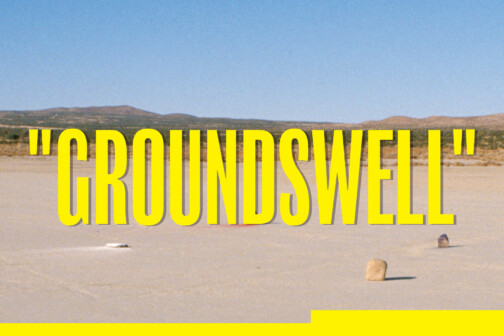
“Groundswell” will be the first true survey of women artists from the period. If there’s one trait the women in this exhibition share, it’s a reverence for the land, an interest in caring for the planet the way museums preserve a rare work of art. One of them, Lita Albuquerque, describes the earth as both a drawing surface for the artists to create upon and earth as the art itself. In that case, the role of the land artist can sometimes simply be creating a framework to reconsider the world we’re living in.
“Recently, I thought, Wow, if the earth is a sculpture in space, then the cosmos is an installation in which we’re partaking every day,” Albuquerque says.
When putting this exhibition together, Arnold faced several big questions. The first was about what timeline she planned to use. Arguably earthworks are one of the most ancient forms of creation (see: Stonehenge, the Nazca Lines, the pyramids), but the official movement of land art is typically understood to last a little over a decade, ending in 1974 when it became institutionalized. This is when national organizations such as the Dia Art Foundation or city projects such as Artpark Buffalo began creating funding and display opportunities for large-scale works, many of them with more equitable open-call structures.
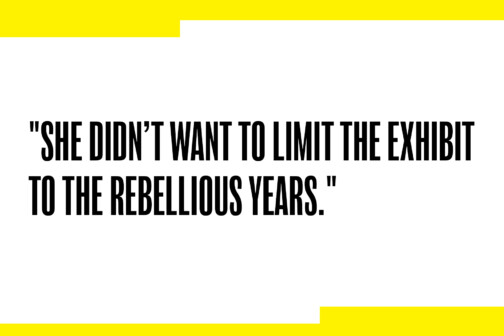
By some definition, working within civic or art world establishments—applying for grants or exhibiting at sculpture parks—went against the very nature of the endeavor. But for Arnold, limiting it to the rogue, rebellious years only assists in the erasure of the women working at the time, many of whom end up tossed into the category of public art. With that in mind, “Groundswell” expands the timeline to 1990.
Another big question was one many museums and galleries have wrestled with throughout the decades: how do you put earthworks into a museum? There are four traditional approaches: documents, non-sites, installation, and site-specific works. This exhibition will employ them all.
The simplest is documentation—whether that be framed planning sketches or dimensions, or photographs and video of the final project. Some works in the exhibition will necessarily be shown in this manner, such as Árbol de la Vida [Tree of Life] (1976), a work in which the Cuban American artist Ana Mendieta stood at the base of a tree, plastered in mud. Mendieta is one of the artists in the show whose work draws a direct link between the female body and the landscape. She was concerned with the violence enacted on “mother earth.”
Arnold was interested in finding various perspectives for this exhibition and approaches to artmaking. She worked with multiple foundations and curators to track down the archives of Beverly Buchanan, an African American artist who explored links between memory and geography. “Groundswell” will feature her sketchbooks, sculptures, and paintings, including one that hasn’t been shown in a museum since the ’70s.
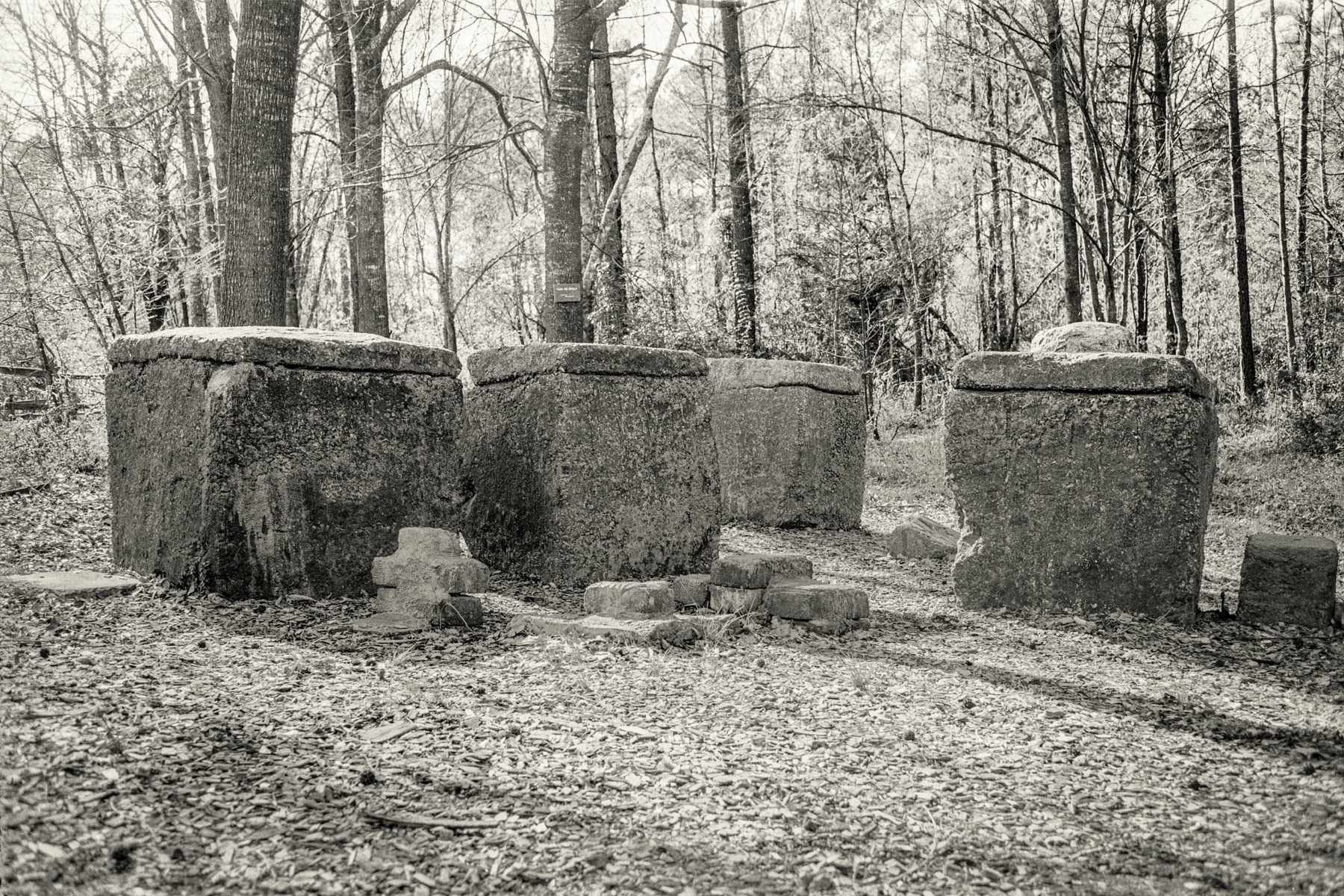
Other earthworks in the show fall into the category Smithson coined as “non-sites,” in which natural elements are incorporated into gallery displays, as a way to signify, but not necessarily replicate, a place in nature. One of the “Groundswell” artists, Michelle Stuart, is known for creating earth boxes, scrolls, and paintings in which she incorporates aspects of nature, framing or even grinding down natural materials into new forms of art. Her process was once described by Lippard as “reduc[ing] mountains to grains of sand.”
For Stuart and a lot of the other women in this exhibition, creating art on the land was less about permanence or ownership. “Most of my works were of the moment. I didn’t do things that I wanted to last forever,” Stuart told ArtNet in 2022. “For me, these were transitory works, for those who wanted to go and participate in them.”
The ephemeral quality of much of the work from that period made Arnold’s job even more difficult. One of the primary installations in the exhibition is a re-creation of Holt’s 1986 sculpture, Pipeline, a large-scale work that will originate outside the Nasher, snake through the gallery, and end in the garden, where it will drip a substance meant to look like oil. It was inspired by Holt’s time in the Alaskan landscape. But Holt, who died in 2014, left behind only a few fixed parameters: it would be a 12-inch steel pipe; it was to be assembled by tradespeople; it would have an outside-inside-outside path. Arnold has been working with a team of art conservators and a ductwork company to re-create this sculpture.
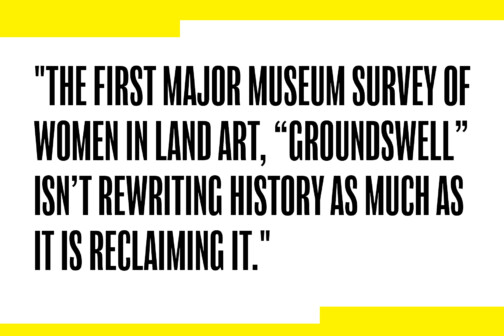
“This is a remake of a sculpture that I think is so important,” Arnold says. “And now that we’ve figured out how to adapt something that hasn’t been made since the artist was living, hopefully the sculpture can have another life at other institutions moving forward.”
Another installation will be Maren Hassinger’s Blanket of Branches, which was originally created in 1986 for the Contemporary Arts Forum in Santa Barbara. Hassinger pieced together an immersive canopy of collected tree branches and invited her artist friends, including 2023 Nasher Prize winner Senga Nengudi, to perform beneath them. In that way, the dead branches took on new life. Visitors to “Groundswell” will walk beneath a new iteration of it to enter the museum.
But to really understand the way art can interplay with nature, visitors to “Groundswell” will once again have to leave the museum. Arnold has included Fair Park Lagoon as one of the exhibition’s works, which she believes is one of the most important pieces of land art made by a woman. Patricia Johanson’s sculpture, which was completed in 1986, consists of terra-cotta-colored structures that snake around and through the five-block water feature that sits behind what was once the Science Place. The design was based on two aquatic plants native to Texas: Sagittaria platphylla, or the delta duckpotato, and Pteris multifida, a fern.
Although it is not a fully realized piece due to management changes midway through the project, the end result accomplished the goal of the commission, which was to stave off erosion of the banks of the lagoon. This commission also allowed Johanson to take her drawing and sculpture practice off the page and out into the world. Specifically, her 1969 “House & Garden” series, in which she envisioned creating water gardens from endangered environments.
“It’s an incredible example of land art in Texas,” Arnold says. “And it’s also this crazy successful work of public art. It’s completely accessible, and people and families have all these memories they attach to it.”

That many of the people who have interacted with it don’t treat it with the reverence with which they might treat a Jackson Pollock painting, a Mark di Suvero sculpture, or even Smithson’s Spiral Jetty makes it all the more interesting in Arnold’s mind. While her male counterparts were using dynamite and bulldozers to carve into mountains, Johanson was researching what plants could restore the biological ecosystem of a lagoon in Dallas.
The story of land art, at least the one Arnold is trying to tell, is not one of artists trying to control nature, but artists in conversation with the earth, with ecosystems, with history—and with one another. As the first major museum survey of women in land art, “Groundswell” isn’t rewriting history as much as it is reclaiming it by filling in the blank pages.
“I’m really interested in pulling apart that narrative of land art as leaving the studio and going into virgin territory,” Arnold says. “There is no such thing as an empty landscape. There are no empty deserts. There’s a stream under the Nasher.”
To find the water’s path, Miss looked for any traces of it in old maps and the shape of the land itself. She went down into parking garages, listening for it, and she walked various paths from the Nasher to the Trinity River over and over again, looking closely at the ground.
Finally, one day after a heavy rain, she says, a man pulled up in a truck atop the levee with the information she needed—the name of someone who could share with her the overlay of the Dallas branch. For Miss, tracing the stream was both a form of artmaking and a collaboration with the city and the museum. And with the earth itself.
This story originally appeared in the October issue of D Magazine with the headline, “Women of Earth.” Write to [email protected].


